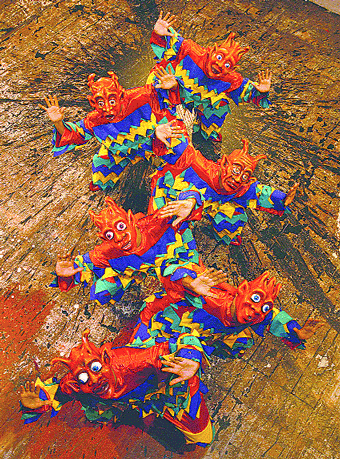Perú Negro’s frothy, cloud-free entertainment
If the African heritage of Peru—a legacy of the Spanish slave trade—one day becomes as widely known and welcomed by Norteamericanos as similar cultural riches of Brazil and Cuba, we’ll owe thanks in large part to the confection known as Perú Negro. For two hours, this accomplished folkloric troupe, led by artistic director and lead percussionist Jaime Ronaldo Campos Ponce, enchanted a huge Lincoln Center Out of Doors audience at the Damrosch Park Bandshell.
Perú Negro’s sound is a throwback to the kind of rollicking Latin and Caribbean music I grew up hearing in New York during the ‘50s and early ‘60s—the very years when historic black culture began to gain the long-withheld respect of Peruvian society. The ensemble’s stagecraft recalls the gracious, cloud-free entertainment much prized in that American era. The company’s musical rhythms—entwining African, Spanish, and indigenous identities—reminded me of Cuba’s own but with a gentler percolation, as light on the ears as the company’s frothy dancing was easy on the eyes. The opening dance “Festejo Ritmo” introduced a sleek, disciplined chorus of willowy ladies in ruffled dresses with their spritely gentlemen, all groomed to be seductive but proper, never raunchy. Even when Mónica Dueñas—Campos’ wife, the company’s mighty lead singer, and quite a dancer herself—hoisted the hem of her skirt to show off her gams, nothing felt unseemly. Dressed in Crayola-colored costumes and horned masks, the scampering, Mischief-making, hand-jiving devils of “Son de los Diablos” exuded only charm. As in a Carnival parade, they were secret little vices projected upon the stage and made irresistibly lovable.
Other numbers included a wondrous tap ensemble for six men (“Zapateo II”) and a giddy, if precisely organized, parody of the colonial masters’ minuets and waltzes (“Toro Mata”). “Ollita” offered some of the best examples of Afro-Peruvian synthesis—a fastidious working of minute rhythms where feet, hips, shoulders, arms, and heads all have their say. Women twirl and spool inward and outward with skirts rippling like layers of frosting on a wedding cake; the men’s slick footwork wondrously double-times the ladies’ pace. “Zamacueca,” the courtship dance, was another winning production with its couples’ flirtatious semaphore of handkerchiefs and merrily rocking hips, the women’s straw hats cocked to one side of their heads.
The excellent dancers selected from the full company for this engagement included Fiorella Ayala, Graciela Bramón, Eder Campos, Percy Chinchilla, José Durand Milagro Elguera, José Martínez, Vanesa Rivadeneyra, José Saldamando, and Milagros Valdivia. In addition to Dueñas and Campos, the musical ensemble included Oscar Brunce (percussion, vocals), Marcos Campos (percussion/lead vocals), Mariano Liy (bass), Williams Nicasio (percussion), Frank Perez (guitar), and Yolanda Tello (vocalist). Mercedes Campos and Soledad Ysusqui designed the sumptuous costuming in keeping with the tradition established by the late founder, Ronaldo Campos de La Colina—everything must be done just so.
gaycitynews.com


































